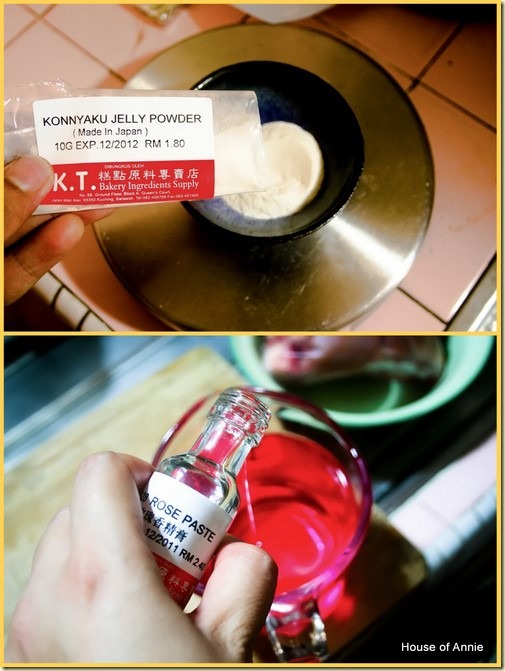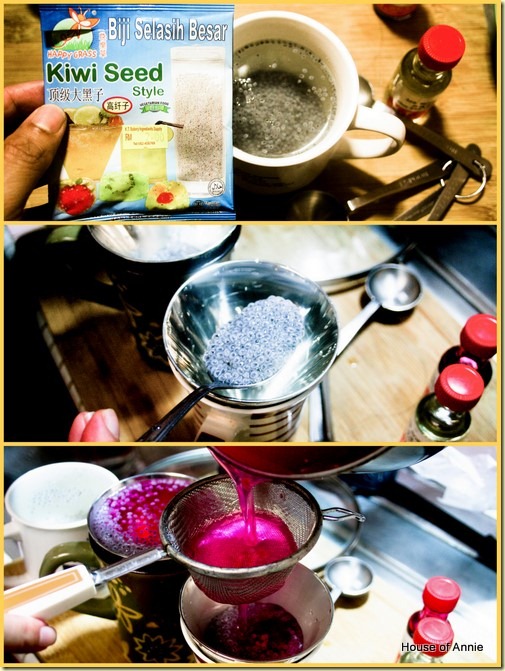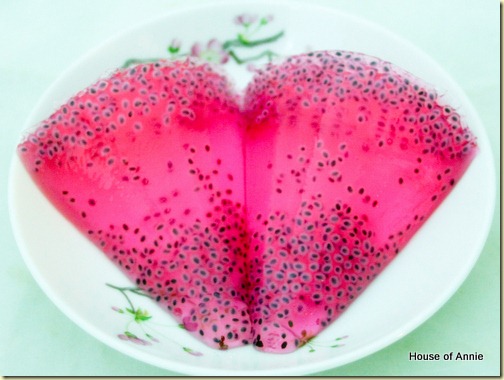When Nate and I first discussed taking part in Royal Selangor’s “Get Your Jelly On” challenge, we were not sure if we could blog every day for a whole month. I was more uncertain of creating jellies for a whole month.
If you are a long-time follower of our blog, you will have noticed that I hardly make jellies. There was only one recipe on our blog for Rainbow Jello and that was it. It’s not that I don’t make jellies, it’s that most of the time, I just use ready made jelly powders and serve it once it’s firm. There’s nothing much to blog about that.
However, now that we’ve been challenged to do this, it’s been quite fun brain-storming ideas on what we can do with these molds. We’ve been thinking about all types of different ways to use the molds (and some of them include non-jelly recipes). Generally, I figured that anything that is good to drink is probably also good to eat as a jelly. As I thought of that, I wanted to try making this particular jelly–Sirap Selasih or Rose syrup with holy basil seeds.
A Hit With the Family
Here in Kuching, we often stop at this one coffee shop, Kluang Station, for drinks. The one drink that is a big hit with my family is Sirap Selasih. As a kid, I loved drinks that contained biji selasih (holy basil seeds) because they looked like frog eggs (you know how kids are so tickled by the idea of consuming something that is normally gross and weird? Are you the same?) These days, I still love the drink and my kids are just as tickled by the seeds as I used to be. FUN!
Anyway, one of the first ideas I had while brainstorming was to turn this drink into a jelly. I decided to use konnyaku powder for this jelly because I liked the texture of konnyaku–it has a bouncy, chewy effect that gelatine and agar agar lacks. Believe it or not, this would be my first time using konnyaku to create a jelly!
Sirap Selasih (Rose syrup and holy basil seeds) Jelly Recipe
for 2 Royal Selangor Jelly moulds (makes 2 cups of jelly)
Prep time: 30 min ; Total time: 3 hours
Ingredients
5 g konnyaku powder
500 ml water
1/2 Tbsp rose paste
2-3 drops of pink coloring (if you can find concentrated rose syrup, you can omit the rose paste and coloring)
5-6 Tbsp sugar
1 tsp holy basil seeds (biji selasih) soaked in two cups of warm water
Method:
1. Soak biji selasih in warm water for two minutes. Drain the seeds. Set aside.
2. Add rose paste and pink coloring to 500 ml of water. Mix. If you like your water to look more pink, add more coloring as desired.
Measuring Konnyaku Powder and Adding Rose Paste
3. Bring rose syrup water to a boil. Add sugar and mix till dissolved. Taste mixture–it should be sweeter than what is normal to you.
4. Add konnyaku powder slowly and whisk till all the powder has dissolved in the syrup (no worries if you get some lumps, just strain it out). Turn heat to low and continue to stir the syrup until thickened.
5. Pour syrup into molds and add the biji selasih. Stir them into the jelly so that they are incorporated and not just floating on top.
6. Chill the jellies until firm, about 3 hours and preferably overnight.
7. Unmold and serve.
Konnyaku Cooking Tips
Here’s what I’ve learned from my experience:
1. Konnyaku powder needs to go into hot water. You also need to put the powder in slowly. Dumping it all in at one go is not a good idea as this will lead to lumps which are deathly hard to whisk away.
2. Biji selasih seeds puff up to a large mass. One teaspoon of black seeds becomes 5 Tablespoons or more of the stuff so don’t use too much of it. They are super easy to work with. All you need to do is put the seeds into two cups of warm water and in two minutes they will have a coat of gel around the seeds. It’s like magic!
Soaking Biji Selasih and Adding to the Moulds
3. When adding the biji selasih seeds to the rose syrup jelly, stir them in and continue to push the seeds down until the konnyaku starts to set a little. This way you seeds won’t all end up at the top of your mould. It it totally cool to see the seeds suspended in the middle of your jelly.
4. When you taste your jelly hot, it will taste sweet enough. At that point, you should add another tablespoon or more of sugar because once they chill in the fridge and firm up, the sweetness will be muted.
So far, from all our experiments, the kids have given this two thumbs up for flavor. They’ve been enjoying our experiments and love that they are getting dessert everyday. Hmm….I’m getting worried about all the sugar that we’re consuming. Thankfully, we have some savory ideas coming up later.
One caution on using konnyaku jelly. Because of its texture and chewiness, this is one jelly where you have to chew carefully when eating. This is especially true when kids are involved as young kids have been known to choke on konnyaku jellies before. So, be watchful when serving them to your young children.
But don’t let this caution keep you from making your own jellies. Purchase a jelly mould from Royal Selangor, and the proceeds go towards supporting the Breast Cancer Welfare Association of Malaysia. In addition, Malaysian customers will get a chance to win their own Olympus Pen Lite E-PL3 camera!
For your jelly-making enjoyment, a little classic Biji – I mean Bee Gees music 😉
We ♥ You!
Cheers, Annie
Breast Cancer Fact: Breast cancer is the most common cancer among Malaysian women, but sadly, between 50 and 60 per cent aren’t diagnosed until the late stages. Visit the Breast Cancer Welfare Association website for more information.




How cute! I never liked eating frog eggs, but I remember falling into a local pond on occasion while I was catching tad poles into a bucket… hang on, we are talking food here!
I’ve heard of the rose syrup combination from a friend. I was going to make it but you beat me to it! 🙂 Good work!
Love the look of these jellies especially with the biji selasih floating around. I tried making this but the biji selasih just set on the top. Thanks for the tips.
I just had this drink last Fri. I did used selasih seeds in my ribena konnyaku jelly last month 😀
I love how the selasih seeds are suspended in the jelly. If I want a less chewier jelly, I usually omit the citric acid powder for the konnyaku powder. Nowadays I suspect they lump everything together for easy convenience, hence one has to be careful about what to buy.
Nice, vibrant colour …. this jelly!
I have never made jelly to be honest, but agar agar yes..
I love the bright colour of this jelly and what’s more, the basil seeds! I heart!
Oooh…that’s such a brilliant color! I love it! The basil seeds creep me out a bit though…like little bugs. I need a taste to persuade me they’re not. Right now.
The basil seeds have a kind of jelly-like outer coating, and a kiwi seed-like crunchy center. You might be able to find a holy basil seed drink at your local Asian grocery.
This is gorgeous! I have never used konnyaku jelly powder before but now I’ll have to look out for them when I’m at the supermarket. The intense pink color of the jelly is just stunning.
Great idea to turn a classic Msian drink to a konnyaku jelly! I like my jellies vibrant in colour such as these. Because they make it more fun to eat and there’s not a lot of food that I enjoy seeing trippy neon colours in, but jelly is def an exception! =D
I also had the same imagination of it being frog eggs whenever I came across basil seeds in desserts when I was growing up in Malaysia. Your creation is strikingly beautiful with the vibrant red and pink colour!
I love it, it’s so pretty and I am a big fan of rosewater and I really want to make this!
kiwi seeds added to the jelly makes the design so awesome…great job!
Hi! Annie
This is very creative!! I never think of making dessert from Konnyakku, though I eat it almost everyday. Is is also interesting idea to add holy basil seeds to the jelly. Yummy! Great recipe and presentation.:-)
where can i get the biji seeds?
Isabelle,
welcome, and thanks for the question.
We purchased the biji selasih from our local baking supply store.
May I know which store exactly in Kuching is it, Annie? I live in Kuching too 🙂 And someone in AU is now obsessed with it 😀
ISobel,
thanks for your question. The baking supply store that we frequent the most here in Kuching is called KT Bakery Ingredients Supply, in the Queen’s Court building at King Centre.
Hi there! I couldn’t find rose paste , can I use rose essence instead? Or they are just the same? Lol thank you!
Kitz,
thanks for your question. Rose essence should be fine.